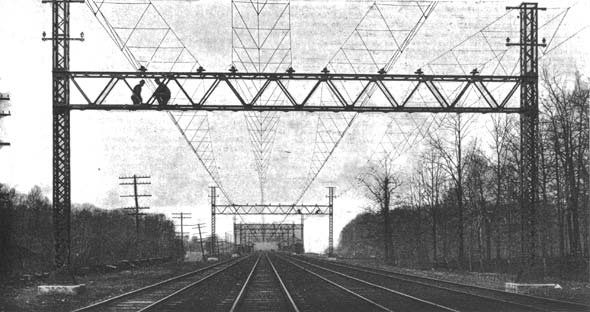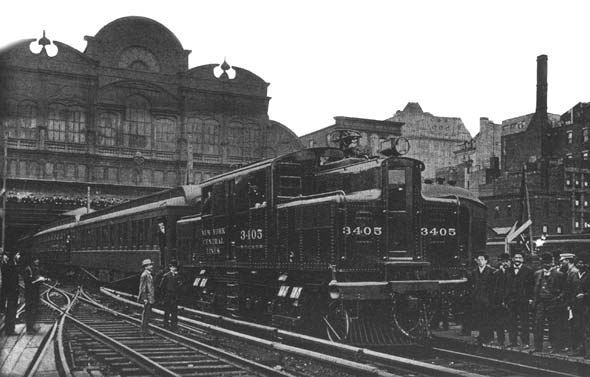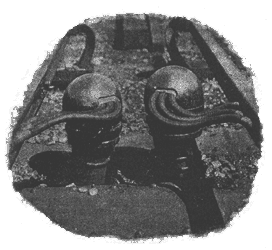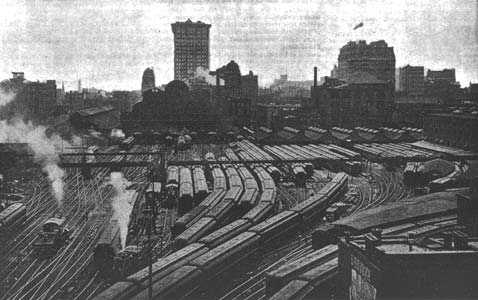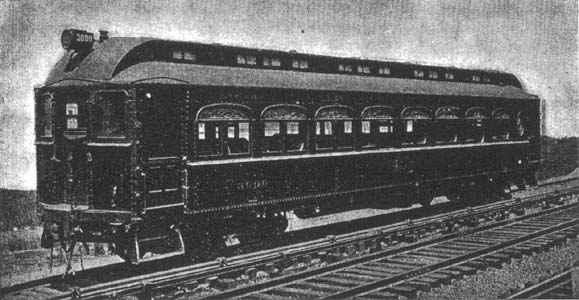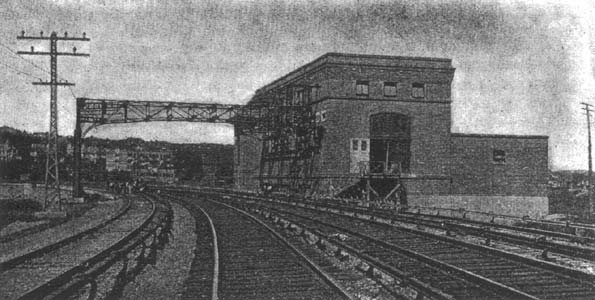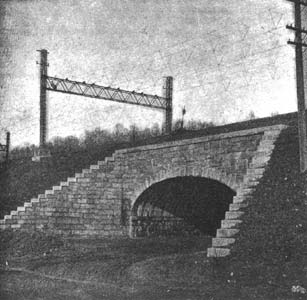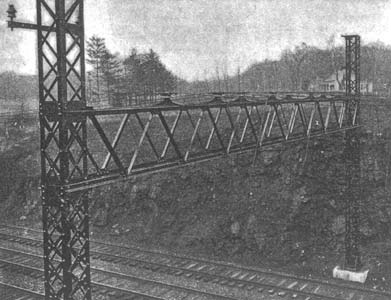New York Central and New Haven Railroad, U-966 shown in photos
|
[Trade Journal] Publication: Scientific American New York, NY, United States |
|||||||||||||||||||||||||||||||||||||
|
ELECTRIFICATION OF THE NEW YORK CENTRAL AND NEW HAVEN RAILROADS. [See page 72.]
OPENING OF ELECTRIC SERVICE OF THE NEW YORK CENTRAL AND THE NEW HAVEN RAILROADS.
The people who expected to enter the Grand Central Station on some specified day of opening, and find the noisy and more or less dirty steam locomotives gone and their place taken by the silent and cleanly electric locomotives and motor cars, have been doubtless much disappointed to find that the installation of electric service at this famous terminal is not going to be made in any such swift and wholesale fashion. On the contrary, so gradual will be the change, that no one will be able to say exactly when the era of steam ended and that of electric traction began. The explanation of the comparative slowness of the change is to be found in the enormous magnitude of the operations, constructive and administrative, which are involved; in the fact that the whole of the work has to be carried through in the midst of what is perhaps the greatest congestion of terminal traffic to be found in any steam railroad center in this country; and in the tact that much of the work of electrificatlon, at least in its application to these two great railroad systems, is more or less novel and has had to be built, and is now being tried out, without very much past experience to go upon. Consequently, although the new depressed station at 42d Street, which occupies the easterly portion of the terminal property, has been in service for about a month, the New York Central system is operating at present only about sixteen electrical trains a day on the local service to Yonkers. The New Haven system is about to open its electrical service by running only eight electrical trains daily between New Rochelle and 42d Street.
We have so frequently described the character of the improvements being made by these two railroads, that we will do no more in the present article than recapitulate the leading features of the work. The changes involved include the electrifying of the New York terminal for a distance of 34 miles on the main line from the Grand Central Station, and for 24 miles on the Harlem Division as far as White Plains, and the New Haven line from Woodlawn to Stamford. At present, only the first electrical zone of the New York Central, extending from the Grand Central Station to High Bridge on the main line, and to Wakefleld on the Harlem Division, has been completed and put in operation, while the New Haven line will in a few days inaugurate its service from New Rochelle to New York. Temporary yards have been built at the two former places; but ultimately the great transfer points will be at Croton, on the main line, and White Plains on the Harlem Division, and at Stamford on the New Haven line. The local service of the New York Central is handled by trains which, for the present, are made up of motor cars and trailers, but which, ultimately, will be made up of motor cars alone, the multiple unit system of control being used. The motor cars are equipped with two 250-horse-power motors to the car, so that an eight-car train of all motor cars will have the great capacity of 4,000 horse-power, from which it will be seen that the speed of this service can be made as high as the demands of traffic and the judgment of the company wish to make it. The new motor cars, as shown in our engraving, are of the all-steel type; they are electrically heated and lighted, and are provided with the hygienic woven cane seats and backs. A novel feature is the provision of electrical fans at each end of the car for securing good ventilation. The whole of the suburban service will ultimately be handled on the lower level of the new double-deck terminal station.
The heavy long-distance and express service will be hauled by electric locomotives of the type shown in our front-page engraving. This is a powerful and massive machine, weighing 95 tons, with 69 tons on the drivers. It is even more powerful than it looks, its maximum horse-power being 3,200, or double that of the heaviest steam locomotives engaged at present in hauling the express trains. The electric locomotive has advantages over the steam locomotive on every point of comparison. Its weight is 95 tons as against 162 tons; its maximum horse-power, 3,200 as against 1,600; its length, 37 feet as against 62 feet; and in spite of its smaller weight, the weight on drivers is 69 tons as against 65 tons of the express steam locomotive. That these splendid engines will be fully equal to their work, is shown by the tests made in experimental service, at Schenectady, when an eight-car train weighing 336 tons reached a speed of 30 miles per hour in 60 seconds, which corresponds to an acceleration of one-half mile per hour per second.
The New York Central electric zone has been built to operate with the direct current transmitted through the third rail. Two power stations have been built, one at Yonkers, the other at Port Morris; they are in duplicate, and each has a maximum capacity of 40,000 horse-power. The three-phase alternating current is produced by turbo-generators of the Curtis and General Electric type, stepped up and transmitted to substations of the general type shown in one of the accompanying illustrations, where it is stepped down to 660-volt direct current, at which pressure it is collected from the third rail by the contact shoes of the locomotives and motor cars.
The electrical commission of the New York Central Company is to be congratulated upon the excellent way in which they have worked out the constructive features of the transmission line and the third rail, both of which, as will be seen from our illustration, are very compact in construction and sightly in appearance. The third rail is carried on brackets bolted to the ties, and is excellently protected on the side and head by wood lagging. Contact is had with the under surface of the rail, and such a thing as accidental injury to employees and others, by contact with the track and feeder rails, would be impossible except under extraordinary circumstances. The line is carried on tapered latticed posts, of graceful design bolted securely to concrete bases. The electric zone of the New York, New Haven & Hartford Railroad extends for a distance of 22 miles from Stamford to Woodlawn, from which point the New Haven trains run over the tracks of the New York Central to 42d Street. After careful consideration of the relative advantages of operation under the alternating and the direct-current system, the company decided in favor of the former, and the equipment of the line and the design of the power station and motive power was given to the Westinghouse Electric and Manufacturing Company. The power station has been built at Cos Cob, adjoining the waterside and the company's main line, where three turbine driven generators have been installed, which are so wound that they will supply either single-phase three-phase current. The current is supplied to the trolley system at a pressure of 11,000 volts, and of course there are none of the transforming stations along the line which form part of the equipment of any low-pressure direct-current system. Each locomotive however, is provided with a pair of transformers which step down the current to the working pressure. The current is collected from the overhead line by means of a pair of pantograph-type bow trolleys. Eight collecting shoes are also provided, for operating on the New York Central's third-rail system.
The construction of the transmission line and the trolley line forms perhaps the most interesting feature of the New Haven Railroad equipment. It was realized that for supplying current to trains, which frequently run over this section at speeds of as high as from 70 to 75 miles an hour, it was necessary to provide a trolley wire which would be true both as to level and line, as distinguished from the loosely hung and swaying wires of the ordinary trolley car service. The construction is as follows: At every 300 feet there is erected, upon massive concrete bases, a pair of heavy latticed posts about 2 feet square in section, which carry, at a height of about 25 feet above the tracks, a deep transverse latticed girder. The tops of the vertical posts project above this girder, and upon the projecting portions are strung the wires of the transmission line and signal service, etc. The latticed girder serves to carry heavy porcelain insulators, upon which are strung the 1/2-inch steel cables, which form the catenary from which the trolley wire is suspended. There are two of these catenaries for each trolley wire, and they are "cradled" by being drawn in toward each other, much the same way as the cables of the Brooklyn suspension bridge. The catenary cables are braced to each other and attached to the horizontal trolley wire below them by means of triangles made of 3/8-inch wire. The triangles decrease in section from the girders toward the center of the span, and thereby serve to hold the catenaries to their curve and the copper trolley wire to its true line and level. The trolley wire is attached to the bottom of the triangles by means of clips, which fit into grooves which run along the wire, one on each side of it. The wire has a height of about 3/8 of an inch and a width of about 1/4 of an inch, and the current will be taken from the wire by the two horizontal bars, 2 1/2 feet wide, of the locomotive trolleys.
The New Haven locomotives are relatively of small hauling capacity compared with the powerful electric locomotives of the New York Central service. They measure 36 feet 4 inches over all, and weigh about 85 tons. Each locomotive has four 250-horse-power motors, nominal rating, and each has developed a maximum power of about 1,450 horse-power, or considerably less than one-half the maximum power developed by the New York Central. Hence it will be necessary to couple two of these engines to make schedule time with the heaviest long-distance trains, although it is hoped that one locomotive will prove sufficient to haul the suburban trains. As we have mentioned above, from Stamford to Woodlawn the locomotives will operate under the alternating current, taking power from the overhead line; from Woodlawn to New York, current will be taken by the contact shoes from the third rail, and the locomotives will operate by direct current.
|
